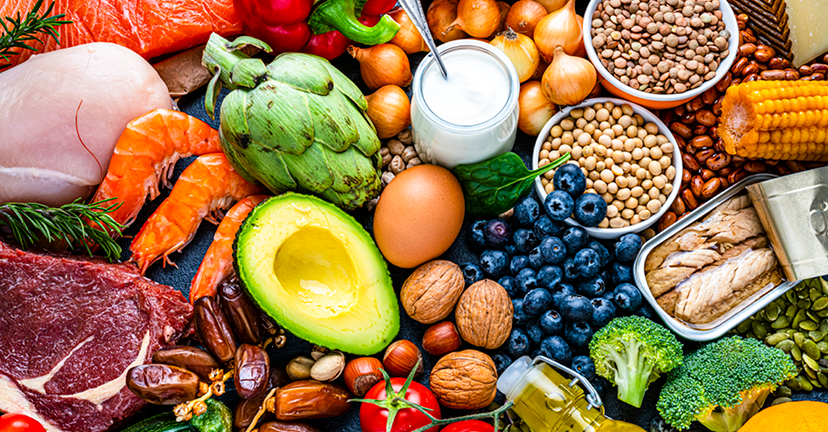 Resolutions abound in the New Year, particularly those that connect food and health. Weight loss is still top of mind for many after the indulgence of the holidays, but more and more, emphasis is being put on adding nutrition benefits over cutting calories. We have plenty of ways to help you enjoy a fresh take on being well this year.
Fruit and Veggie Hacks
More matters, and there are so many easy ways to add produce to your day. Our Fresh Express salad section keeps bringing new ideas to your table! Enjoy easy prep and great salad variety with added flavor and nutrition boosts from cheese, pepitas, nuts, and fruit accents, included right in the package. Dole and Welch frozen fruits, and PICS frozen vegetables are adding more varieties to their ranks, and make it easy to enjoy smoothies, yogurt parfaits, and inspired oatmeal combinations, and quick dinner prep.
Beverage Bonanza
Keep an eye on beverages all over the store – super seltzers, enhanced waters, drinkable yogurts, teas, added probiotics, and lower calories are all themes in new items and refreshed favorites.
Good Fats
Nuts rule, and Emerald 100 calorie packages help you max the benefits and manage the calories. Avocados continue to climb higher on the health (and taste!) ladder. Add just a little more olive or canola oil to your recipes and enjoy supporting your healthy heart.
Protein Power
Convenient servings and packages help you eat well at home and include a wide variety of lean proteins – check out frozen grilled chicken and deli tubs, string cheese and new options with yogurt and cottage cheese. The trend toward plant protein is also powering up in a lot of delicious and interesting food products. Many new items are designed to help you easily and quickly add delicious ancient grains, lentils, beans and pea protein to your table and snacks.
These are just a few of the food trends you will see as we ring in a healthy New Year – we can’t wait to share them all!
For recipes and inspiration, visit our New Year New You Pinterest board!
Written by Jane N. GolubDirector In-Store Marketing ProgramsNEW DAIRY PURE by Garelick Farms
Resolutions abound in the New Year, particularly those that connect food and health. Weight loss is still top of mind for many after the indulgence of the holidays, but more and more, emphasis is being put on adding nutrition benefits over cutting calories. We have plenty of ways to help you enjoy a fresh take on being well this year.
Fruit and Veggie Hacks
More matters, and there are so many easy ways to add produce to your day. Our Fresh Express salad section keeps bringing new ideas to your table! Enjoy easy prep and great salad variety with added flavor and nutrition boosts from cheese, pepitas, nuts, and fruit accents, included right in the package. Dole and Welch frozen fruits, and PICS frozen vegetables are adding more varieties to their ranks, and make it easy to enjoy smoothies, yogurt parfaits, and inspired oatmeal combinations, and quick dinner prep.
Beverage Bonanza
Keep an eye on beverages all over the store – super seltzers, enhanced waters, drinkable yogurts, teas, added probiotics, and lower calories are all themes in new items and refreshed favorites.
Good Fats
Nuts rule, and Emerald 100 calorie packages help you max the benefits and manage the calories. Avocados continue to climb higher on the health (and taste!) ladder. Add just a little more olive or canola oil to your recipes and enjoy supporting your healthy heart.
Protein Power
Convenient servings and packages help you eat well at home and include a wide variety of lean proteins – check out frozen grilled chicken and deli tubs, string cheese and new options with yogurt and cottage cheese. The trend toward plant protein is also powering up in a lot of delicious and interesting food products. Many new items are designed to help you easily and quickly add delicious ancient grains, lentils, beans and pea protein to your table and snacks.
These are just a few of the food trends you will see as we ring in a healthy New Year – we can’t wait to share them all!
For recipes and inspiration, visit our New Year New You Pinterest board!
Written by Jane N. GolubDirector In-Store Marketing ProgramsNEW DAIRY PURE by Garelick Farms New Dairy Pure by Garelick Farms is kept pure with a 5 Point Purity checklist so your milk’s purity is something you never have to worry about. Dairy Pure by Garelick Farms is the same pure milk inside, now backed by the 5 Point Purity checklist below to ensure their milk starts pure and stays pure:
New Dairy Pure by Garelick Farms is kept pure with a 5 Point Purity checklist so your milk’s purity is something you never have to worry about. Dairy Pure by Garelick Farms is the same pure milk inside, now backed by the 5 Point Purity checklist below to ensure their milk starts pure and stays pure:
- Our Farmer’s pledge not to use artificial growth hormones
- We test all milk for antibiotics
- Continuously quality tested to ensure purity
- Only from cows fed a nutritious diet
- Cold shipped fresh from your trusted dairy within hours
Garelick Farms is passionate about the purity of their milk so you can rest assured you’re getting only the purest healthiest milk possible. Visit www.DairyPureMilk.com for more information.
Look for Dairy Pure by Garelick Farms in the Milk section of the Dairy aisle.
DURACELL EASYTAB HEARING AID BATTERIES
 Hearing loss is a common problem, affecting 35 million Americans. Duracell EasyTab Hearing Aid Batteries are easy to hold, replace and remove. An extra-long tab makes it simple to handle and its lightweight packaging is easy to open. They are color-coded by size in yellow, orange, brown and blue so you won’t have any trouble finding the size that is right for you.
Hearing loss is a common problem, affecting 35 million Americans. Duracell EasyTab Hearing Aid Batteries are easy to hold, replace and remove. An extra-long tab makes it simple to handle and its lightweight packaging is easy to open. They are color-coded by size in yellow, orange, brown and blue so you won’t have any trouble finding the size that is right for you.
EasyTab Hearing Aid Batteries improve the quality of life for people with arthritis and have received an Ease-of-Use commendation from the Arthritis Foundation. They have also been recognized as one of the top durable goods with a Pharmacist Recommendation Award from The Pharmacy Times OTC Guide.
-
Long tab for easy handling
-
EasyTab Hearing Aid Batteries are available in sizes 10, 13, 312 and 675
-
Lightweight easy-to-open packaging
-
Color-coded by size
-
0% Mercury
Look for Duracell EasyTab Hearing Aid Batteries on the Battery Rack.
Written by Jane N. GolubDirector In-Store Marketing ProgramsNEW DAIRY PURE by Garelick Farms New Dairy Pure by Garelick Farms is kept pure with a 5 Point Purity checklist so your milk’s purity is something you never have to worry about. Dairy Pure by Garelick Farms is the same pure milk inside, now backed by the 5 Point Purity checklist below to ensure their milk starts pure and stays pure:
New Dairy Pure by Garelick Farms is kept pure with a 5 Point Purity checklist so your milk’s purity is something you never have to worry about. Dairy Pure by Garelick Farms is the same pure milk inside, now backed by the 5 Point Purity checklist below to ensure their milk starts pure and stays pure:
- Our Farmer’s pledge not to use artificial growth hormones
- We test all milk for antibiotics
- Continuously quality tested to ensure purity
- Only from cows fed a nutritious diet
- Cold shipped fresh from your trusted dairy within hours
Garelick Farms is passionate about the purity of their milk so you can rest assured you’re getting only the purest healthiest milk possible. Visit www.DairyPureMilk.com for more information.
Look for Dairy Pure by Garelick Farms in the Milk section of the Dairy aisle.
DURACELL EASYTAB HEARING AID BATTERIES
 Hearing loss is a common problem, affecting 35 million Americans. Duracell EasyTab Hearing Aid Batteries are easy to hold, replace and remove. An extra-long tab makes it simple to handle and its lightweight packaging is easy to open. They are color-coded by size in yellow, orange, brown and blue so you won’t have any trouble finding the size that is right for you.
Hearing loss is a common problem, affecting 35 million Americans. Duracell EasyTab Hearing Aid Batteries are easy to hold, replace and remove. An extra-long tab makes it simple to handle and its lightweight packaging is easy to open. They are color-coded by size in yellow, orange, brown and blue so you won’t have any trouble finding the size that is right for you.
EasyTab Hearing Aid Batteries improve the quality of life for people with arthritis and have received an Ease-of-Use commendation from the Arthritis Foundation. They have also been recognized as one of the top durable goods with a Pharmacist Recommendation Award from The Pharmacy Times OTC Guide.
-
Long tab for easy handling
-
EasyTab Hearing Aid Batteries are available in sizes 10, 13, 312 and 675
-
Lightweight easy-to-open packaging
-
Color-coded by size
-
0% Mercury
Look for Duracell EasyTab Hearing Aid Batteries on the Battery Rack.









